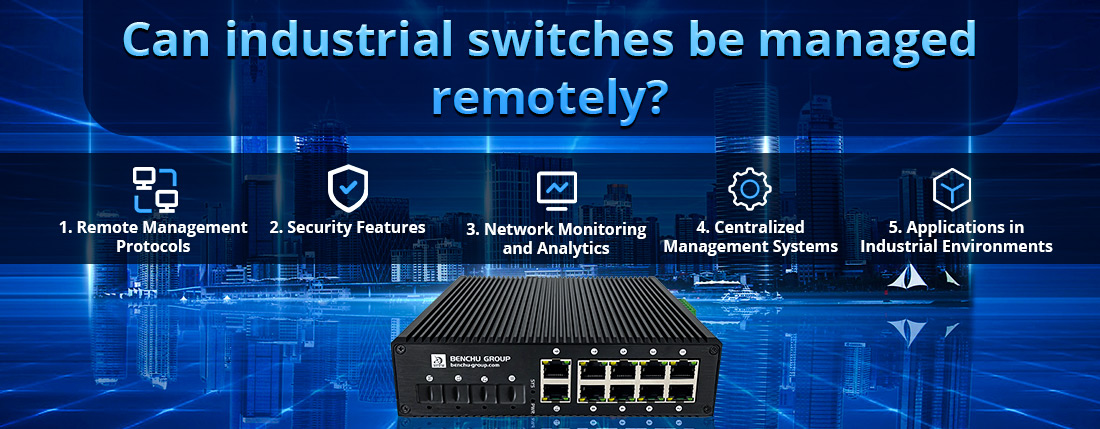
Yes, industrial switches can be managed remotely, which is a critical feature for maintaining and optimizing network operations in industrial environments. Remote management capabilities enhance the functionality, security, and reliability of industrial networks. Here’s a detailed description of how industrial switches support remote management:
1. Remote Management Protocols
a. SNMP (Simple Network Management Protocol)
--- Network Monitoring: SNMP is a widely used protocol for network management that enables administrators to monitor the performance and health of industrial switches remotely. It allows for querying switch status, port utilization, and error statistics.
--- Alerts and Notifications: SNMP can be configured to send alerts or notifications to administrators in case of faults, performance degradation, or configuration changes. This helps in proactive troubleshooting and maintenance.
b. CLI (Command Line Interface)
--- Access via SSH or Telnet: Many industrial switches support remote management through a command line interface accessed via SSH (Secure Shell) or Telnet. Administrators can log in remotely to configure settings, troubleshoot issues, and update firmware.
--- Scriptable Configurations: CLI access allows for automated configurations and scripting, enabling bulk configuration changes across multiple switches, saving time and reducing errors.
c. Web-Based Management Interfaces
--- User-Friendly Interfaces: Industrial switches often come with a web-based management interface, allowing users to configure and manage the switch through a browser. This interface typically provides a graphical representation of the network and the switch’s status.
--- Remote Access: Web-based interfaces enable remote access from anywhere with internet connectivity, making it easy for network administrators to monitor and manage switches without being physically present.
2. Security Features
a. Secure Access Control
--- User Authentication: Remote management capabilities often include robust user authentication methods, such as username/password combinations or even multi-factor authentication, to restrict access to authorized personnel only.
--- Role-Based Access Control: Many industrial switches allow for role-based access control (RBAC), enabling administrators to set different permission levels for users based on their roles. This minimizes the risk of unauthorized changes or access.
b. Encrypted Communication
--- Data Security: Protocols like SSH and HTTPS encrypt data transmitted during remote management sessions, ensuring that sensitive information and configurations are protected from eavesdropping and tampering.
3. Network Monitoring and Analytics
a. Performance Monitoring
--- Real-Time Insights: Remote management tools provide real-time insights into switch performance, including port status, bandwidth utilization, and error rates, enabling administrators to identify and resolve issues quickly.
--- Historical Data Analysis: Many industrial switches store historical data that can be analyzed to track performance trends, helping identify potential problems before they affect network operations.
b. Firmware Updates and Configuration Management
--- Remote Updates: Administrators can remotely update firmware and configurations on industrial switches, ensuring they run the latest software versions for improved performance and security.
--- Backup and Restore Configurations: Remote management allows for easy backup and restoration of configurations, facilitating quick recovery in case of hardware failures or configuration errors.
4. Centralized Management Systems
a. Network Management Software
--- Integrated Solutions: Many organizations use centralized network management software that supports multiple devices, including industrial switches. These systems provide a unified interface for managing the entire network infrastructure.
--- Automated Configuration: These solutions often include features for automated device discovery, configuration management, and policy enforcement across all network devices, streamlining operations.
b. Cloud-Based Management
--- Cloud Management Platforms: Some industrial switches offer cloud-based management solutions that enable remote monitoring and management from anywhere. Cloud platforms often provide additional analytics, reporting, and scalability.
--- Scalability and Flexibility: Cloud management allows organizations to scale their networks quickly without worrying about the limitations of local management tools or infrastructure.
5. Applications in Industrial Environments
a. Remote Locations
--- Monitoring Remote Assets: Industrial switches deployed in remote or difficult-to-access locations, such as oil rigs, mines, or telecommunications towers, can be monitored and managed remotely. This reduces the need for on-site visits and expedites troubleshooting.
b. Smart Manufacturing
--- IoT Integration: In smart manufacturing environments, industrial switches often connect to various devices, sensors, and IoT systems. Remote management enables real-time monitoring and analytics, optimizing production processes and enhancing operational efficiency.
c. Security Monitoring
--- Surveillance Systems: Industrial switches used in security monitoring systems can be managed remotely, allowing for real-time access to camera feeds and alarm systems. Administrators can quickly respond to incidents, enhancing overall security.
6. Benefits of Remote Management
a. Operational Efficiency
--- Reduced Downtime: Remote management enables faster identification and resolution of issues, minimizing network downtime and improving overall operational efficiency.
--- Cost Savings: Remote access reduces the need for on-site visits, saving time and travel costs for IT personnel while enabling more efficient use of resources.
b. Improved Troubleshooting
--- Faster Response Times: With remote access to diagnostic tools and monitoring data, IT teams can quickly identify and troubleshoot issues without waiting for on-site intervention.
--- Proactive Maintenance: Remote management allows for proactive monitoring of switch health and performance, enabling teams to address potential issues before they escalate.
7. Conclusion
The capability for remote management of industrial switches is a vital feature that enhances network reliability, efficiency, and security in industrial environments. With support for various management protocols, secure access, and centralized management systems, remote management allows organizations to monitor, configure, and troubleshoot switches from anywhere, ensuring continuous operation and reducing the need for on-site interventions. This flexibility is particularly valuable in industries where uptime is critical, and operational costs must be kept in check.